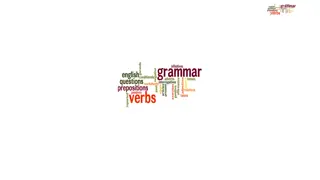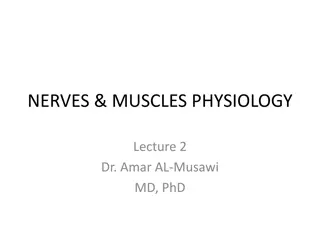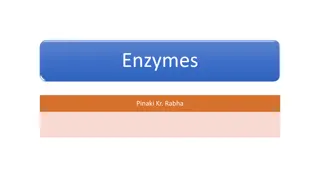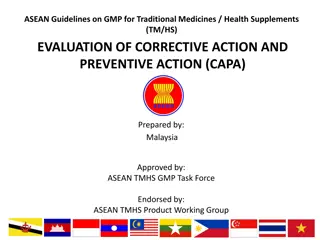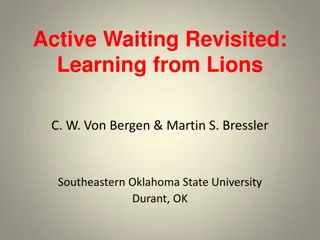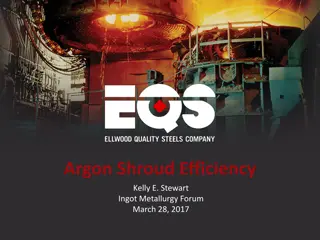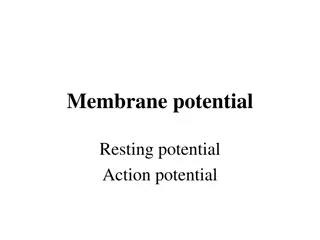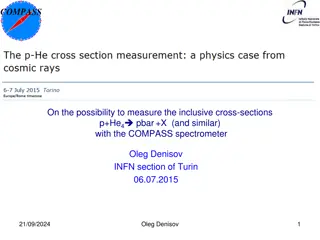MRF Approach in Action: Shroud of Turin Study
In this engaging presentation by Dale Glover on the Guy Powell Show, the Minimal Relevant Features (MRF) approach is discussed in relation to studying the images on the Shroud of Turin. The methodology involves evaluating image-forming hypotheses based on plausibility, explanatory power, simplicity, and more. Key MRFs are outlined, including photo negativity, body image uniformity, and bloodstain characteristics, all supported by credible scientific literature. Explore the fascinating world of Shroud of Turin research with this insightful discussion.
Download Presentation

Please find below an Image/Link to download the presentation.
The content on the website is provided AS IS for your information and personal use only. It may not be sold, licensed, or shared on other websites without obtaining consent from the author.If you encounter any issues during the download, it is possible that the publisher has removed the file from their server.
You are allowed to download the files provided on this website for personal or commercial use, subject to the condition that they are used lawfully. All files are the property of their respective owners.
The content on the website is provided AS IS for your information and personal use only. It may not be sold, licensed, or shared on other websites without obtaining consent from the author.
E N D
Presentation Transcript
Guy Powell Show: MRF Approach In Action By: Dale Glover (Real Seekers Podcast)
1. My Minimal Relevant Features Approach ( MRF ) Approach Similar to Dr. Gary Habermas Minimal Facts Approach to the historical evidence for Jesus Resurrection, I have developed the Minimal Relevant Features (MRF) Approach to studying the Shroud of Turin s images (mostly in relation to the fulfilment of criteria A) & B) of Premise #8 for identifying religion-authenticating miracles in my 11-Premise argument for Christianity). As Mike Licona does with Resurrection historicity, my approach is divided into two fundamental parts; i) Facts ii) Method (Explanatory Evaluations) Facts: The Minimal Relevant Features refer to the physical and chemical properties of the Shroud s body and bloodstain images as discovered and reported on in secular peer- reviewed science journals by the STURP scientists (1978-1981) and subsequent scientific testing. There are 2 criteria to qualify as an MRF ; Feature is highly evidenced as substantiated in the credible peer-reviewed science literature. At least 2/3 of informed experts accept the feature as a proven fact.
MRF Methodology Methodology: To evaluate the various image forming hypotheses that claim to explain the Shroud images MRF s I first assess how well each hypothesis is able to explain each MRF. Then, I perform an overall evaluation of the image forming mechanism in the light of the Best Explanation Inference ( BEI ) criteria; 1. Plausibility- refers to the hypothesis ability to be implied by or at least consistent to a greater degree and by a greater number of other accepted truths (or background knowledge) than other hypotheses. 2. Explanatory Scope- accounts for the quantity of facts that can be accounted for by a given hypothesis; the hypothesis that accounts for the most data has the greatest explanatory scope. 3. Explanatory Power- the quality of the explanation/hypothesis in relation to explaining the relevant facts; the hypothesis that entails the least amount of effort, vagueness or ambiguity has the greater explanatory power. 4. Simplicity (Less Ad Hoc-ness)- refers to the employment of non-evidenced assumptions; the superior hypothesis is the one that employs the least amount of these
2. What are Some of the MRFs? I have an excel document listing them all, but below I will list some of the main ones = shroud-part-40-good-final-book-verison-hypothesis-feature-comparison. 1. Photo Negativity (lights and darks reversal) 2. Body Image Uniformity (Colour Intensity & Density) 3. Topographical Information (3-Dimensionality) 4. Vertically Mapped Wrapping Distortions 5. Body Image Superficiality (fabric, thread and fibril levels) & No Capillary Flow or Saturation. 6. No Body Sides/Top of Head but Continuous (including Non-Contact Zones) 7. Body Image Diffuseness yet Relatively High Resolution 8. No brushstrokes, directionality, layering nor UV Fluorescence for body images. 9. Bloodstains: Positive, cemented and non-superficial, no body images underneath blood/serum, no major damage, smearing or alteration (appears as flowed and congealed on human skin). Also, carmine coloured with perhaps darker perimeters around them, etc. 10. No paint, pigments, dyes, dry powder, photosensitizers or decomposition liquids.
3. Image Forming Hypotheses The various image-forming hypotheses proposed thus far, all fit into 1 of 3 major categories; 1. Ordinary Artistic Mechanisms- A medieval artist/craftsman and his team manufactured the Shroud images as an artistic work of one sort or another (intelligent human design required to some extent). 2. Ordinary Naturalistic Mechanisms- a dead corpse was put in the Shroud and without any intelligent design, some ordinary natural mechanism/s operated on the body so as to create the images on their own. 3. Extraordinary/Supernatural Mechanisms- God, either directly or indirectly through an intermediary agent/s created the Shroud images using some kind of extraordinary natural and/or supernatural mechanisms.
Image-Forming Hypotheses Cont. Non-Miraculous Theories Miraculous Theories Ordinary Naturalistic Mechanisms Extraordinary Electrostatic Mechanisms Extraordinary Radiation Mechanisms Ordinary Artistic Mechanisms Direct Contact (John German) White Light Pulse (Jean-Baptiste Rinaudo) Corona Discharge (Giulio Fanti) Traditional Painting (Walter McCrone) Gas Diffusion/Maillard Reaction (Raymond Rogers) X-Rays Divine Photography (Giulio Fanti) Frottage/Powder- Rubbing (Luigi Garlaschelli) (Giles Carter) Electric-Charge Separation (Dan Spicer & E.T. Toton VUV (Ultraviolet) (John Jackson) Scorch (Pesce Delfino) Charged Particles (Bob Rucker, Arthur Lind, etc.) Natural Earthquake Radiation (Alberto Carpinteri, et al. Proto-Photo (Nicholas Allen)
4. Walter McCrones Traditional Painting Hypothesis Traditional painting was the first Shroud skeptical hypothesis trying to explain away the Shroud images- alleged by the greedy Bishop Pierre D Arcy in 1389 A.D. Walter McCrone, an Atheist, after studying some Shroud samples given to him using his outdated Polarized Light Microscope reported that he found iron oxide on the image samples, and from that finding he concluded that the iron oxide was evidence pointing to tempera paint, and therefore, to the painting of the Shroud image by a human artist in the medieval period. Furthermore, he also claimed to find vermillion on a single blood sample ( 3CB ) and concluded the bloodstains must have been touched up with vermillion pigment. McCrone mostly published his results in the journal Microscope; a journal that he was the editor of--- that is NOT proper scientific peer-review. How do we assess this theory s performance based on the MRF s?
MRF Evaluation- Painting Hypothesis (Walter McCrone) 1. Negativity Explanation Questionable: Why would an artist paint a reverse/negative image? There is no known historical precedent for this artistic approach other than for the Shroud itself and copies made later. 2. Uniformity A painting method can achieve this result the uniform maximum colour densities but fail to have uniform intensity as per varying paint applications. 3. Tri-Dimensionality ( 3D ) Inconsistent: Experiments utilizing certified forensic artists unable to recreate due to a combination of limited visual discernment of shading at low contrast and inadequate motor (eye/brain/hand) coordination in applying correct shading values. 4. Vertical Mapping It seems inconceivable that an artist would be aware of such subtle distortions, let alone craft such subtleties into a 3D reverse/negative image 5. Superficiality The Shroud image was examined microscopically by STURP at both 32X and 64X. Painting is inconsistent with the use of any viscous or low viscous painting medium. Such mediums would leave evidence of cementation between fibers or capillary flow/action.
MRF Evaluation- Painting Hypothesis (Walter McCrone) Cont. Explanation 6. Image Diffuseness & No brushstrokes Inconsistent: As all other known paintings have detectable brushstrokes and definable borders. 7. Bloodstains Inconsistent: Possible to paint using anti- coagulated blood. But no evidence has been found of image forming materials being deposited over the blood or serum retraction rings and it is inconsistent that an artist could avoid leaving any evidence of disturbing the invisible serum retraction rings. Possibly inconsistent with darker perimeters of bloodstains too (see experiments of Mark Antonacci and Art Lind). 8. No Paint/Pigments/Dyes Inconsistent: By definition there should be significant amounts of pigments exclusively in image areas if this hypothesis is true.
STURPs No Paint, Pigments or Dyes (Painting Hypothesis Cont.) In 1978 STURP tested the cloth for all known organic and inorganic pigments, paints and dyes and didn t find any evidence for them composing the body images nor the bloodstains. In the words of STURP scientists, the fibers are only colored (yellow-brown) due to chemical reactions involving the polysaccharides composing the linen fibers: oxidation, dehydration and conjugation . Furthermore, they go on to describe that the colored linen fibers are only colored due to a chemical reaction involving the fibers themselves. There is no evidence of a coating or extraneous material added to the fibers to cause the image color. Dozens of spectral, micro-chemical, chemical and physical tests by multiple scientists of differing religious backgrounds all confirmed STURP s findings and were thus published in 26 of the world s most prestigious science journals. Unfortunately, McCrone never studied the Shroud in person like STURP did and thus he did not know that STURP scientists Morris and Schwalbe found that iron oxide was found to be distributed over the entire cloth uniformly, not just in the body image or bloodstain areas. The reason for this iron was due to the retting process. Additionally, the vermillion pigment was indeed paint, but it was not present in any of the other image/bloodstain samples found and is thus due to simple contamination over the centuries. McCrone and STURP both found various particles of everything from pink nylon to insect parts to even a modern felt-tip pen mark; it would be ludicrous to assume the artist made the Shroud images out of bug parts because the leg of an insect was found in one sample from the Shroud. A little common sense on the part of skeptics is required please!
Traditional Painting ( BEI Assessment) Plausibility: the notion of any artist prior to the 20th century), came up with the idea to paint an image in the negative, encode 3D information and have the necessary hand, eye and brain coordination to encode wrapping distortions precisely correlated to a vertical mapping path, is shear fantasy. The body images are barely visible at close range and any alleged artist would have needed to stand far back from the Shroud just to double check his own work. Medieval art historians like Agnostic Thomas DeWessalow say there are no known precedents for such an artistic technique; the Shroud s images are completely unique in the entire history of art. Explanatory Scope & Power: This hypothesis fails to fulfill every single MRF in one way or another. Less Ad Hoc: Al Adler stated, a sceptic would need about a dozen such different compounds in order to explain what he can with one compound namely, real blood that s the difference with how science works, if you tried to put those 12-15 compounds up vs. the far simpler explanation of it being real blood into the scientific literature in a reference journal, it would be bounced instantly . McCrone assumed that the medieval artist used a heavily diluted mixture of 0.01% iron oxide in a 0.01% gelatin binding medium solution (making the predominant ingredient essentially water); yet he also readily admits that all other paintings typically have a 1 millimeter (or more) thick paint layer/s and hence display observable 2D directional brush strokes unlike the Shroud.
Frottage/Powder-Rubbing Hypothesis (Luigi Garlaschelli) In 2009, Italian Atheist and chemist Luigi Garlaschelli and his team settled on a frottage (French for rubbing ) technique as the most likely method. 1. A pigment containing acidic compounds in a water-based slurry was rubbed on a prepared linen cloth molded over an actual human model. The human model was used for the frontal and dorsal images below the neck level. The acid used by Garlaschelli was sulfuric acid. 2. A shallow bas-relief was constructed out of plaster-of-Paris for the facial image and the same rubbing, or frottage method, was used to obtain the raw image. Garlaschelli reported that although a Shroud-like image can be produced by a rubbing technique on a human body , the face must be obtained from a bas-relief to avoid the inescapable wrap-around distortion . 3. Next the scourge marks were added. As Garlaschelli comments, scourge marks and blood stains on the Shroud are not fuzzy but rather sharp. Thus, for our reproduction they were not added by rubbing. Instead, the pigment (this time a very diluted suspension of red ochre, cinnabar and alizarin in water) was gently applied with a small brush, which also gives rise to the fine, well-defined parallel scratches seen in some of these marks. 4. The cloth was then artificially aged. It was heated in a specially designed oven, then washed, and finally, ironed flat. This final heating process simulated what Garlaschelli proposed happened naturally to the cunningly painted Shroud over years and even centuries the effects of time. That is, the Shroud image we see today is not at all the Shroud image that was first artistically created. The pigment essentially eroded away over time and a faint pseudo negative image with some 3- dimensional properties was left where the acid in the original slurry medium chemically reacted with a superficial layer of the linen cloth. 5. Finally, the major bloodstains were painted on the cloth and a pen-sized butane blowtorch was used to mimic the large burn scars from the 1532 fire.
MRF Evaluation- Powder-Rubbing Hypothesis (Luigi Garlaschelli) Explanation 1. Negativity Consistent: This method would achieve this MRF. 2. Uniformity All Powder-Rubbing methods fail to account for the uniform intensity of colour as there will be variations in application of powder & Walter McCrone demonstrated the inevitable problem of snow- fencing on the fibers. 3. Tri-Dimensionality ( 3D ) Inconsistent: Luigi s method does not, on close scrutiny, match the 3D effects of the Shroud, particularly in the area of the face; made up of mostly flat plateau areas corresponding to contact areas and valleys corresponding to non-contact areas with abrupt vertical cliffs between. This is in contrast to the Shroud that has 3D properties that show fine variations of altitude . Also the hands are embedded into the body and the legs have unnatural looking lumps and bumps that are not consistent with the Shroud image.
MRF Evaluation- Powder-Rubbing Hypothesis (Luigi Garlaschelli) 4. Vertical Mapping Explanation Inconsistent: The Shroud wrapping distortions are subtle; an artist would NOT have anticipated this requirement and then been able to execute it with the realism observed on the Shroud with a contact dependent method such as a bas-relief. Also, he used an actual human body for acquiring the frontal and dorsal body images; the model simply turned over onto his stomach to create the dorsal image. This wouldn t work in a simple fashion, as the model would have to assume the same relative posture for the frontal and dorsal images (like a true bas-relief). 5. Superficiality Questionable: There has been no publicized detailed 3rd party microscopic examination of Garlaschelli s results. The distribution and properties of the color at the surface of the threads and of individual fibers is different from the Shroud . The color is only on the side of the fibers surface exposed to the acid . Also in 2002, Fanti and Moroni showed that the percentage of saturated pixels in an experimentally that L.G. s method was 60% (+/- 5%), saturated while the percentage for the Shroud is at most 23% (+/-5%). 6. Bloodstains Inconsistent: Garlaschelli openly stated that he used paint to mimic blood and wounds as a second step after image formation. Clearly in his method there are colored image fibers under the painted blood.
Powder-Rubbing Hypothesis ( BEI Assessment) Plausibility: no historical evidence suggesting that powder-rubbing methods were used at any time prior to the last half of the 17th century or possibly as late as the second half of the 19th century. Also, Explanatory Scope: Garlaschelli s requires two different methods to produce Shroud-like results; it doesn t present one coherent and historically plausible method that a medieval artist could have utilized to fulfill all the MRF s. Even other skeptics using this method say, it is impossible to satisfy simultaneously all observations reported for the Turin image . Explanatory Power: Fails to explain several MRF s (see above). Less Ad Hoc: assumes that all the powdered pigments have oxidized completely over the centuries (leaving no residual trace particles to account for the body-images today apart from the resultant yellow staining and/or acidic degradation), but the bloodstains painting particles have somehow still remained in sufficient quantity to explain the visibility of such images.
Scorch Hypothesis The Italian scientist Pesce Delfino used a metal sculpture of a human face, heated it to approximately 200 degrees C (about 392 degrees F), and then impressed a piece of linen cloth onto the sculpture in order to leave a scorched image. Delfino limited his effort to creating a facial image only and he also did not attempt to include any bloodstains. He realized that a 3D sculpture did not work and thus he used a bas-relief method to avoid some unwanted wrapping distortions.
MRF Evaluation- Scorch Hypothesis (Pesce Delfino) Explanation 1. Negativity Consistent 2. Uniformity Inconsistent: it would require outstanding temperature control for the frontal and dorsal image to have the same maximum image density. Fail intensity uniformity as the contact in the flat areas or small depressions of the bas-relief would be light while the contact with higher areas (like the nose) would be more intense. Questionable: capable of accounting for Shroud image s cloth-body distance correlation. However, experiments led to the conclusion that the bas-relief would need to be very shallow which raises questions about depth info being encoded properly like the Shroud. Inconsistent: a shallow bas-relief complicates reproducing the wrapping distortions found on the Shroud where the wrapping distortions are consistent with an actual human body and a vertical projection of the body image. Inconsistent: Experiments show that the heat will 3. Tri-Dimensionality ( 3D ) 4. Vertical Mapping 5. Superficiality
MRF Evaluation- Scorch Hypothesis (Pesce Delfino) 5. Superficiality Explanation Inconsistent: Experiments show that the heat will discolor through the thickness of the Shroud in about 1/100 to 1/10 of a second so you would have to have the bas relief on the cloth and take it away on a timescale like that in order to be consistent with what is observed. 6. No UV Fluorescence Questionable: High temperature scorches fluoresce red under ultraviolet but the Shroud body images do not. Low temperature scorch may have been used but may not do 3D .
Scorch Hypothesis ( BEI Assessment) Plausibility: such methods have been tried by various scientists and all fail; it is therefore unique despite ample opportunity to be duplicated using this method. Radiating heat is isotropic and thus would diffuse in all directions, contrary to the Shroud. Scorch methods are also likely to scorch through the linen cloth in fractions of a second, it is inconceivable that a human artist (modern or medieval) would be able to control the scorching mechanism in such a way as to not violate this image superficiality. Explanatory Scope: it seems impossible, using a scorch template, to have an image that is at the same time 1) superficial at fabric level (let alone at the thread and fibril levels] and 2) contrasted but not over-scorched and 3) with 3D properties. Explanatory Power: Fails to explain multiple MRF s. Several ambiguous factors. Less Ad Hoc: Scorch proponents must postulate that the body images have lost all the inevitable brown or black burned fibrils through abrasion over the centuries; but the burn holes caused during the 1532 fire, despite having been around for centuries, show no signs of any such abrasion .
Direct Contact Hypothesis (John German) This type of image-forming mechanism involves a chemical reaction that takes place as direct result of direct/intimate-contact between a human body (usually presumed to be dead and covered in sweat, aloes, blood, oils and/or other embalming substances) and the linen Shroud. John German was a STURP scientist who proposed a variant version of the Direct-contact theory. The main difference with his version being that his proposal suggested that at first, only the high points of the body touching the cloth were encoded and then later on, due to the body decomposing & the moisture in the air, the cloth was wetted causing it to begin to sag and conform more and more to other areas of the body. Hence more and more body image areas became encoded which in turn caused the body images to have differing darker/lighter image intensities. The higher parts had longer contact with the cloth and thus became darker as a result; this in turn supposedly accounted for the 3D Information encoded on the Shroud images
MRF Evaluation- Direct-Contact Hypothesis (John German) 1. Negativity 2. Uniformity Consistent Inconsistent: The weight of the body and gravity affecting any decomposition liquids or aromatic embalming oils would inevitably leave traces of discernable differences in image intensity between the frontal and dorsal image. Inconsistent: binary characteristics pose a fundamental problem with this type of process (natural body contact), for such a mechanism doesn t provide the latitude to correlate intensity with a continuum of relief variations- the face esp. would be heavily distorted. Inconsistent: Would follow Path A and also probably produce wrap-around (Mask of Agamemnon) effects Inconsistent: to achieve this uniform superficiality with a wet body producing decomposition liquids; they would penetrate into the cloth through capillary action. Also more saturated and decomposition liquids should be observed. 3. Tri-Dimensionality ( 3D ) 4. Vertical Mapping 5. Superficiality
Direct Contact Hypothesis ( BEI Assessment) Plausibility: The Shroud is Unique! Out of all the ancient Egyptian mummies wrapped in linen wrappings and/or other burial garments/shrouds that scholars and archeologists have been able to study from antiquity, none of these other linen burial garments or shrouds have been demonstrated to possess images with all the features seen on the Shroud of Turin. None of the various attempts by scientists to reproduce a copy of the various Shroud features either in the field (under presumed similar conditions) or in the laboratory with similar control samples using various Direct contact methods, have been able to come anywhere close to recreating the Shroud s body and bloodstain images Explanatory Scope & Power: Fails to explain several MRFs. Less Ad Hoc: such theories must assume that the body was removed before the buildup of any decomposition liquids and further they must postulate that all such molecules involved in the image formation have oxidized completely.
Ray Rogers Gas Diffusion (i.e., the Maillard Reaction) Rogers proposed a Maillard chemical reaction between amines that would hypothetically be generated by a decomposing and an assumed microscopically-thin contamination layer on the Shroud fibers. He proposed that a contamination layer of starch was left on a very thin evaporation surface of the Shroud as a by-product of the manufacturing process of the ancient linen. Rogers demonstrated in experimentation with small samples of linen cloth that a Maillard reaction could lead (qualitatively) to yellow-brown coloring of a linen fabric that was treated to have a thin starch contamination layer. Finally STURP did discover some detectable starch impurities on the Shroud, however Drs. Heller and Adler in their paper A Chemical Investigation of the Shroud of Turin could not identify any starch being present on the Shroud and so Rogers assumption that the thin-contamination layer was present throughout the entire cloth is unproven and controversial. We shall assume it is there for the sake of our evaluation below.
MRF Evaluation- Gas Diffusion (Ray Rogers) 1. Negativity Explanation The gas diffusion image-formation mechanism proposed by Rogers is consistent with this image characteristic. 2. Uniformity Able to explain density uniformity but questionable for uniform intensity (probably not). 3. Tri-Dimensionality ( 3D ) Inconsistent: A diffusing gas model would seem to have no means of conveying this information to the cloth. Experiments conducted to date all show grossly distorted results (see PowerPoint, p.105 VP8). 4. Vertical Mapping Inconsistent: The wrapping distortion image characteristic can only be critically evaluated in conjunction with a high- resolution image that maps body surface points to schematically correlated points. A diffusion image- formation mechanism by definition lacks this correlation (Path E = Emissions above). Rogers himself admitted defeat on this- need to guide gases with other unknown mechanism. 5. Superficiality Consistent: Rogers hypothesized that amine gases reacted with a superficial starch contamination layer left on a micro- thin evaporation surface on the Shroud. Also, in his hypothesis the body was removed from the cloth before sufficient decomposition liquids formed on the body so no cementation of capillary flow. However, the body images would be way more saturated
Gas Diffusion Hypothesis ( BEI Assessment) Plausibility: the Maillard Reaction that Rogers proposed, would not take place unless the body s temperature was approximately between 38-40 degrees Celsius or higher. Yet by the time the body was wrapped in the Shroud and placed in the tomb, it would most unlikely that the body could have maintained such a high temperature. Explanatory Scope & Power: None other than Ray Rogers himself has admitted that his own theory falls far short of the mark, but yet he claims that despite any shortcomings in his experimental results; he maintains that the entire main point in suggesting the Maillard Reaction hypothesis, was merely to recognize that blanket statements about diffusion and resolution can t be supported by simple assumptions alone . Less Ad Hoc: Rogers Maillard Reaction is ad hoc in postulating; i) the body would have been removed in time before sufficient amounts of decomposition liquids accumulated on the Shroud, ii) the presence of spice packs and flowers positioned perfectly to avoid forming the body side images and iii) postulating that the proven detection of starch impurities on the surfaces of linen fibers of the Shroud using microchemical tests such as pyrolysis/mass spectrometry necessarily implies that the Shroud had a pervasive micro-thin layer of starch along its entire surface
5. Charged Particle Radiation (VCRB) Hypothesis The image-forming mechanisms that I find to be most likely personally are ones involving some kind of charged particles like protons and electrons. For example, Bob Rucker s Vertically Collimated Radiation Burst hypothesis and Mark Antonacci s Historically Consistent Hypothesis.
6. Challenges to Image-Formation Question There are a few major problems in answering (definitively) the question of how the Shroud s images were made; A) Philosophical Worldview Bias- Naturalism and scientism/empiricism are amoung the biggest reasons for skepticism and lack of consideration of miraculous explanations for the images; this hinders our investigation. B) Lack of Complete Set of Historical Facts- Some historical details are lost to history and may have some significance in terms of answering the image- formation question (conditions of the body, tomb, etc.). C) Limited Access- The Shroud has only been thoroughly scientifically investigated in person once in 1978. STURP proposed a total of 26 more scientific tests to be done in 1988 but none of them were done. More testing with modern scientific equipment and knowledge can help us answer questions raised from the first 1978 STURP investigation.
7. Unknown/Unspecified Miraculous Image Yes, God may have used a totally unknown supernatural mechanism/series of mechanisms to form the Shroud. Philosophers of action have proposed that miraculous deeds on God s part are basic actions (there are no intermediary mechanisms involved for us to detect or identify at all). Of course, I do think God wants us to identify the images as being miraculously formed in order to come to faith and God has given us reasoning abilities, the scientific method and natural laws and so it also makes sense He might want us to be able to detect how they were made precisely by studying and testing how the images may have formed. Also a basic action leaves us with the confusing proposition that God actively threw off the radiocarbon dates directly when forming the images and not as a natural by-product of the image- forming process- some theological issues there maybe (the Biblical God is not supposed to be the author of undue confusion). Remember, God has provided all Reasonable Real Seekers the means to identify the Shroud images and their formation as religion-authenticating events via detecting divine design behind it (as per my use of Specified Complexity in Intelligent Design theory) and so regardless of any lack of specifics, we can still rationally infer intelligent divine design behind the image formation process. See my Previous Show with Guy here = https://www.youtube.com/watch?v=Pn_tG6XeB5g Also my debate on Miracles with Atheist Jordan from Reason to Doubt = https://www.youtube.com/watch?v=p0DoRiNgKxw
Guys Show Questions Yes Sept 29th at 2 pm EST/Toronto time works for me. I like your questions there, I think I would add the following; 1) Can you give us a quick reminder about your Minimal Relevant Features ("MRF") Approach to studying the Shroud? 2) What are some of the physically and chemically proven properties of the Shroud that you use as "MRF's"? 3) What are some of the current theories as to the image generation process 4) What are some of the reasons we have for disregarding the artistic and natural theories put forward by skeptics? 5) Which theory do you think is the most likely? 6) What are some of the challenges related to determining the image generation process (7) If the image was generated miraculously, is it possible we'll never know how it was generated?



